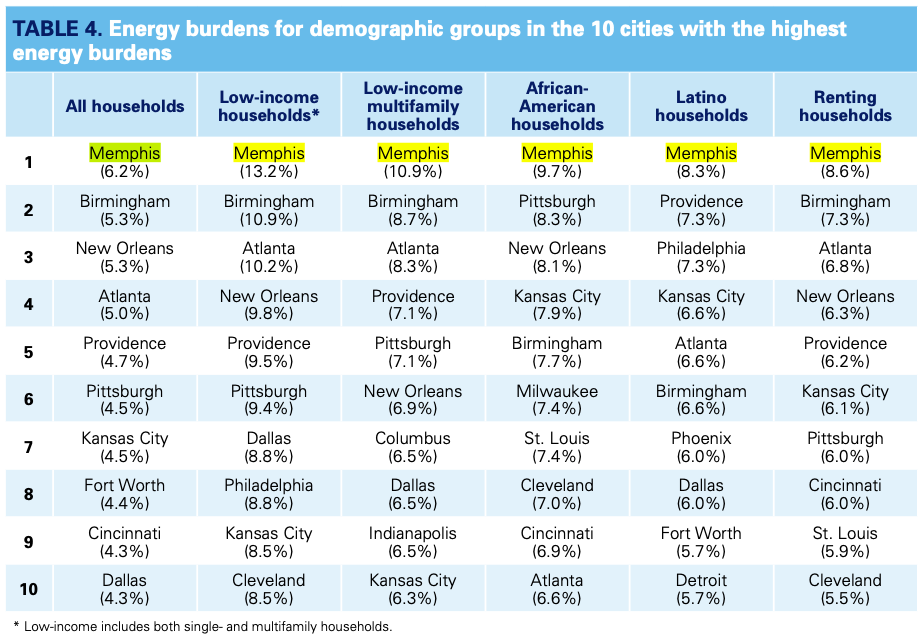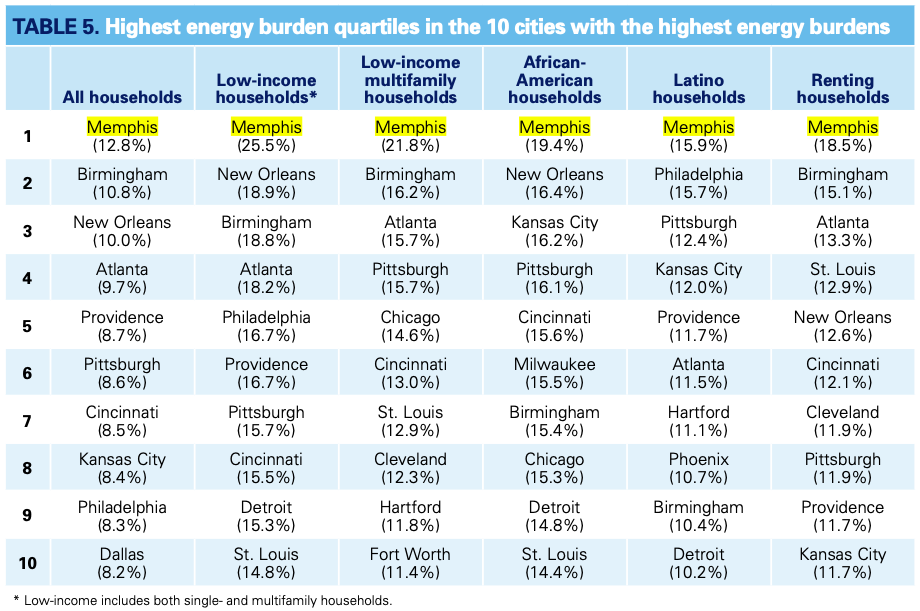Memphis has the most unaffordable energy of any major metro area in the nation.
You may have heard about the energy affordability crisis in Memphis. Perhaps the most authoritative resource on energy affordability in Memphis is the 2016 report, Lifting the High Energy Burden in America’s Largest Cities, from the American Council for an Energy Efficient Economy (ACEEE). This report examined the 48 largest metro areas in the country and how much people pay for energy (electric, gas, and/or other heating fuel) in relation to household income.
ACEEE found that of these major metro areas, Memphians pay the highest percentage of their incomes for energy in the nation: 6.2% on average. For context, the typical threshold for energy costs to be considered unaffordable is above 6% of household income spent on energy, while the report found that the average cost to households in major metro areas nationwide is 3.5% of income.
Energy is Less Affordable for Some
But looking at the average resident does not tell the whole story. When you drill down to certain populations, it becomes clear that energy is much less affordable for certain people. And in all of the sub-groups that ACEEE looked at, Memphis topped the list for unaffordability: low-income households, low-income multifamily households, African-American households, Latino households, and renting households (see table below).

Even this table hides just how unaffordable energy is for many Memphians. While the average low-income Memphian pays 13.2% of their income for energy, a very large number of Memphians who make very little money pay significantly more to keep their lights on and their homes comfortable and safe during scorching summers and winter nights.
Tennessee households earning lower-incomes use less energy than higher-income households, but these lower-income households are paying a much higher percentage of their incomes on their energy bills.
The table below shows what percent of a household’s income is spent on energy by the top 25% of households in each of the select populations.

With this table, we can see that in the Memphis metro area:
- 25% of low-income households pay 25.5% of their income for energy
- 25% of low-income multifamily households pay 21.8% of their income for energy
- 25% of African-American households pay 19.4% of their income for energy
- 25% of Latino households pay 15.9% of their income for energy
- 25% of renting households pay 18.5% of their income for energy
A reminder, from above, the typical threshold for energy costs to be considered unaffordable is above 6% of household income spent on energy, and ACEEE’s report found that the average cost to households in major metro areas nationwide is 3.5% of income. Too many Memphians face costs far exceeding affordability.
As it stands, without significant action, Memphians are facing the most unaffordable energy of any major metro area in the nation.
Memphians Have The Power
It is with this understanding that the discussion over the future of Memphis’ local utility, Memphis Light, Gas and Water (MLGW), and how much it pays for electricity takes on such significance for so many families. Right now, MLGW has a contract to buy electricity from the Tennessee Valley Authority (TVA), but recent studies have shown that Memphians could save hundreds of millions of dollars per year by sourcing energy from alternative supplies. These savings could mean a world of difference in helping to relieve the burden of extremely unaffordable energy for many Memphians.
If it takes leaving TVA to get affordable, equitable, and clean energy for Memphians, the City and MLGW need to keep rapidly advancing the search for alternatives to TVA. Every month the City delays making a decision on whether or not to leave could waste tens of millions of Memphians’ dollars. We look forward to seeing a robust request for proposals (RFP) from the utility soon that will give a clear indication of how many millions of dollars Memphians can save by breaking free from TVA